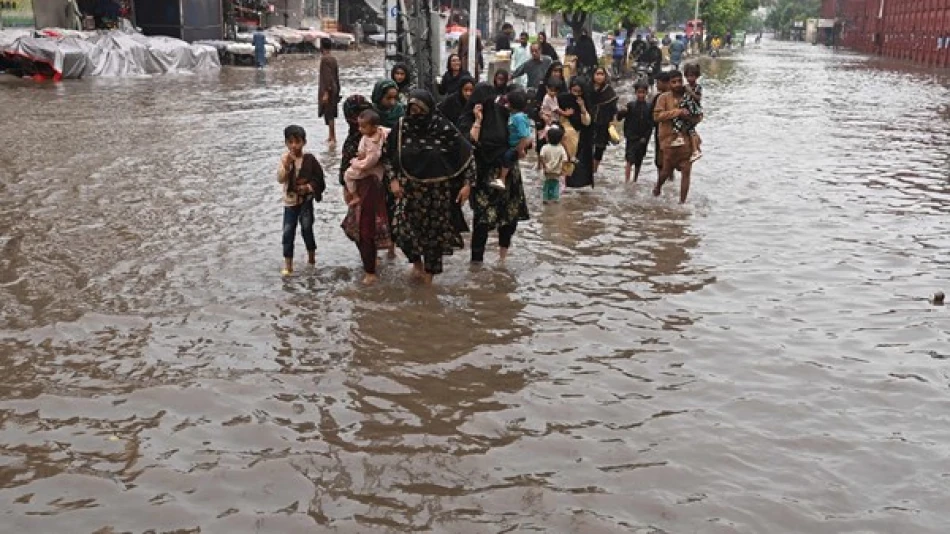
Pakistan Warns of Impending Glacier Flooding: Preparing for Potential Disaster
Pakistan Faces Escalating Climate Crisis as Glacial Lake Floods Threaten Northwestern Regions
Pakistan issued urgent warnings Saturday about impending glacial lake outburst floods in its northwestern territories, as meteorologists predict intensified rainfall patterns that could trigger catastrophic flooding across vulnerable mountain communities. The alert underscores Pakistan's growing vulnerability to climate-driven disasters, with this year's monsoon season already proving deadlier and more destructive than previous years.
Unprecedented Rainfall Patterns Signal Deeper Climate Shift
Anwar Shahzad, spokesperson for Pakistan's National Disaster Management Authority, confirmed that rainfall in Khyber Pakhtunkhwa province has significantly exceeded last year's levels during the same period. This dramatic increase has prompted authorities to issue comprehensive weather warnings, specifically targeting the risk of glacial lake outburst floods (GLOFs) that could devastate downstream communities.
The province, which borders Afghanistan and contains numerous glacial formations in the Hindu Kush mountain range, represents one of the world's most climate-vulnerable regions. Rising temperatures are accelerating the formation of unstable glacial lakes, creating natural dams that can burst without warning and release millions of cubic meters of water downstream.
Temperature Rise Accelerates Glacial Instability
A mid-July communication from the disaster management authority warned that "continuous temperature increases may accelerate snow and glacial melting and subsequent weather events" across at-risk areas. This assessment reflects broader scientific consensus about Pakistan's exposure to glacial lake hazards, with over 3,000 glacial lakes identified in the northern regions.
The Mechanics of Catastrophe
Glacial lake outburst floods occur when natural ice or debris dams fail, often triggered by heavy rainfall, seismic activity, or rapid temperature changes. Unlike regular flooding, GLOFs can generate massive walls of water, rocks, and debris traveling at speeds exceeding 40 kilometers per hour, making evacuation extremely difficult.
Pakistan's mountainous geography amplifies this risk, as narrow valleys channel floodwaters into densely populated areas with limited escape routes. The 2010 Attabad disaster, which created a massive lake after a landslide, demonstrated how quickly such events can displace thousands and disrupt regional connectivity.
Mounting Human and Economic Toll
This year's monsoon season has already extracted a heavy price, with dozens killed and extensive damage to property and infrastructure across Pakistan. The economic implications extend beyond immediate reconstruction costs, as repeated climate disasters strain government resources and deter long-term investment in vulnerable regions.
The agricultural sector, which employs nearly 40% of Pakistan's workforce, faces particular vulnerability. Flooding destroys crops, contaminates water supplies, and damages irrigation infrastructure, creating food security risks that can persist long after floodwaters recede.
Regional Climate Pattern Reflects Global Trends
Pakistan's current crisis mirrors broader climate disruption across South Asia, where changing monsoon patterns and accelerating glacial melt threaten hundreds of millions. The Intergovernmental Panel on Climate Change has identified the Hindu Kush Himalayan region as a climate change hotspot, where temperatures are rising faster than the global average.
Similar challenges affect neighboring countries, with India experiencing unprecedented flooding in Himachal Pradesh and Uttarakhand, while Nepal grapples with increasing GLOF risks. However, Pakistan's limited financial resources and institutional capacity make adaptation particularly challenging compared to regional neighbors.
Infrastructure Vulnerability Compounds Natural Risks
Pakistan's infrastructure deficit amplifies climate risks, as inadequate early warning systems, poor drainage networks, and substandard construction practices increase disaster vulnerability. The China-Pakistan Economic Corridor, a flagship Belt and Road Initiative project, faces mounting climate risks that could affect billions in infrastructure investments.
International development agencies increasingly recognize that traditional disaster response approaches prove insufficient for Pakistan's scale of climate challenges. The focus is shifting toward anticipatory governance systems that can predict and prepare for climate impacts before they occur, though implementation remains limited by resource constraints and institutional capacity gaps.
Most Viewed News

 Layla Al Mansoori
Layla Al Mansoori






